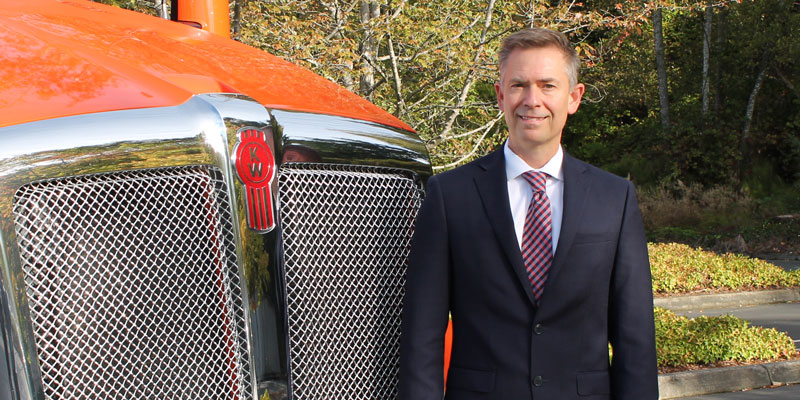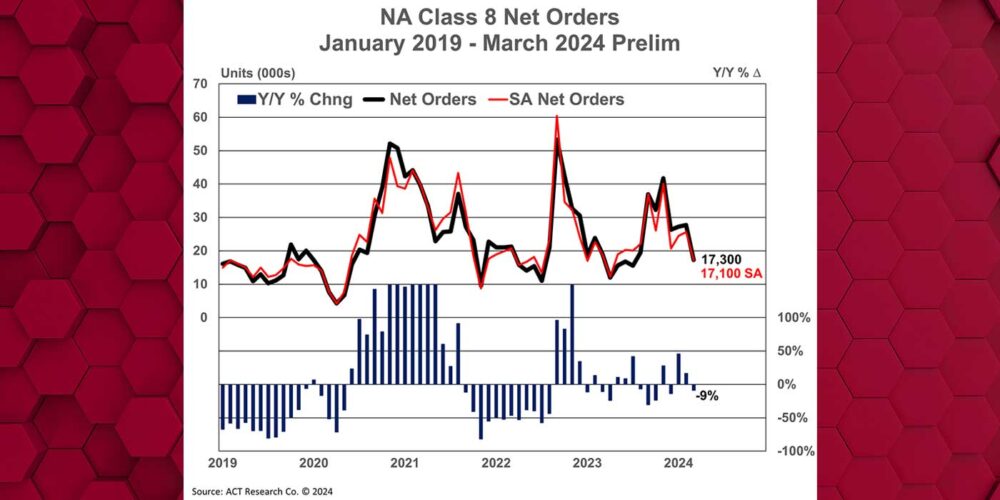The sun is streaming through the shades of Kevin Baney’s corner office at Kenworth headquarters in Kirkland, Washington. It’s a brilliantly sunny morning—a rarity for Washington in October, Kevin tells me. Below these shades is a shelf on which sits three detailed models of Kenworth trucks—the T680, T880 and W990.
Each of these models is incredibly detailed, incorporating every component and detail of their real-life counterparts, inside and out. It’s a daily reminder of Kevin’s responsibility over the models you currently see on the road. Kevin is Kenworth Truck Co.’s general manager and a PACCAR vice president, a role he’s held for the past two months.
“It’s been a fast and furious time,” he says.
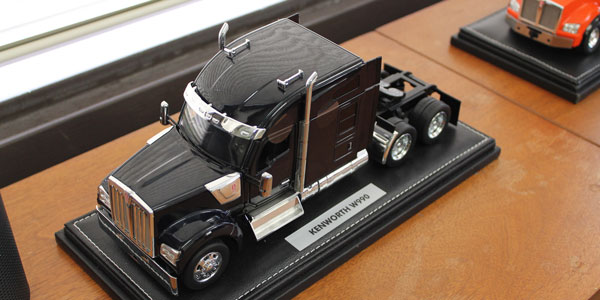
He may be new to this role, but Kevin has spent 25 years with PACCAR, with the past seven being with Kenworth. Many of those years were spent as an engineer, and when he talks about the engineering side of things, his enthusiasm is palpable. The same goes for his attitude toward the trucking industry in general; his excitement about this particular topic is contagious.
Kevin grew up in Texas, and he tells me that he never thought he’d end up in trucking.
“Oftentimes you’ll find employees in the industry who grew up on a farm and drove trucks, so they had that innate passion for trucking,” he says. “I didn’t have that growing up. But it didn’t take long.
“I started right out of the school, and as a mechanical engineer, I wanted to do something automotive related. When the opportunity came to join PACCAR, I was put immediately on an R&D developing team. The first truck I was involved in and then saw go down the road, I was hooked.”
His background—starting off in R&D and engineering, with the last few years being focused on sales—gives Kevin an important perspective as R&D and technology continue to drive constant innovation in the industry.
Kenworth’s big projects deal with game-changing technology like electrification and automation, and Kevin says that the development of this technology is one of the most exciting things about being a truck OEM general manager in 2019.
“With the pace of play and the opportunities, it’s like no other time,” he says. “I think part of what’s sped up the development cycle is the threat of new entrants. They may not be the ultimate competitor, but they’ve at least driven the discussion and activity within the industry.”
“The biggest change for us is that we have always had a history of advanced product development; we just didn’t communicate it.”
He’s referring to newcomers such as Nikola, which is producing hydrogen fuel cell-powered trucks, and Tesla, which made a big splash with the dramatic announcement of its as-yet-unseen Semi in 2017.
So how have these newcomers on the scene changed things for Kenworth?
“The biggest change for us is that we have always had a history of advanced product development; we just didn’t communicate it,” Kevin answers. “And what Tesla really drove is that they would tend to communicate before they even started. And when that happened, dealers and customers would reach out to us and say, ‘Are you doing something like this?’
“It increased our awareness that it’s okay to communicate earlier in the process what we’re doing so that we give the industry confidence that the OEMs that are in the space now are investing and developing these technologies. Whether it’s ADAS, whether it’s alternative powertrains, we’re developing the technology our customers are going to need, and we’ve become a lot more comfortable sharing and communicating our plans.”
But it’s important not to get swept up by the exciting technology and lose sight of the trucks and customers of the present. It’s complicated, and after 25 years of contributing to the puzzle, it’s now Kevin’s job to lead the charge on piecing it together.
In a time in which the industry is constantly shifting and changing, and with more changes looming over the horizon, how does Kevin plan to build on his R&D and sales backgrounds to make sure Kenworth is well positioned for the present and the future?
To answer that, we’ll have to dig deeper into a few of the major aspects of Kenworth’s equipment development.
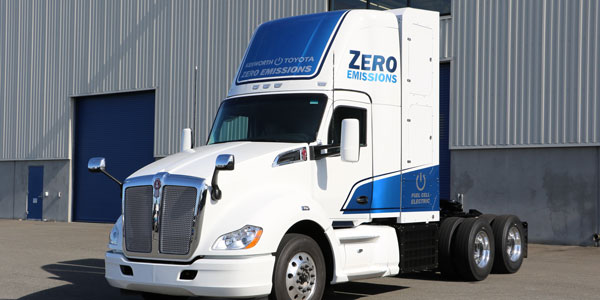
Electrification and zero-emissions
First, let’s turn the calendar back six months and head south from unseasonably sunny Seattle to a blustery April day in Los Angeles.
On this particular day at the Port of Los Angeles, visitors were treated to an unusual sight: a zero-emission Kenworth T680 powered by a Toyota hydrogen fuel cell, running back and forth at the port. A truck that only emits steam, and runs so quietly you would swear it wasn’t on at all, even if you’re sitting in the cab as it drives around at 30 MPH.
The Port event was the launch of a $41 million Zero and Near-Zero Emissions Freight Facilities (ZANZEFF) program provided through a grant awarded by the California Air Resources Board (CARB), with the Port of Los Angeles as the prime applicant, and the Port, Kenworth, Toyota and Shell part of the cooperative effort.
The truck is called the FCEV (which stands for Fuel Cell Electric Vehicle), and it’s the collaboration’s first proof of concept of a hydrogen fuel cell powered truck running routes in a real-world application.
At the port in April, the companies announced that 10 hydrogen-powered trucks will be built as part of the program, and as of today these trucks are in the build stages.
Hydrogen fuel cell technology is a bit of a contrast to trucks with battery electric power. So why did Kenworth decide to invest in hydrogen power for its first attempt at a zero emissions vehicle? I turn to Stephan Olsen, Kenworth’s director of product planning, for the answer here. Stephan’s product planning responsibilities put him in charge of the OEM’s R&D efforts—the kind that Kevin worked on when he started with the company in the 1990s.
“We think that there won’t be one ‘silver bullet’ solution for zero-emissions,” Stephan begins. “We think that battery electric is applicable in certain applications like inner-city delivery, medium-duty applications, and some regional haul, where perhaps carrying capacity isn’t a critical requirement, where trucks can return home on a daily basis for recharging, and trucks that do a lot of stop-and-start can take advantage of regenerative braking.
“Now, on the other hand, trucks that have to travel longer distances—say, 300 miles or more in a day in regional-haul or drayage—we don’t believe those trucks can afford the weight of the batteries,” he continues. “So, for example, if we took a truck that needed to have a 300-mile range, given the battery technology we have today, that truck would have to bear somewhere between 15,000 to 20,000 lbs. of additional weight in batteries. The advantage we see from hydrogen fuel cell technology is that it can deliver zero emissions at significantly reduced weight and also simplified packaging space. So that’s why we’re exploring hydrogen fuel cells.”
Stephan says that Kenworth is working on research and development for battery electric technology as well. And as he mentioned, the OEM doesn’t believe that one of these fuel sources will win out over the other the way DVDs won out over VHS tapes. Zero emissions technology will be more like the myriad video streaming services we have access to today, each offering something slightly different to fill the needs of different customers.
“The decision point for customers between the two is going to be: how much do I need to haul, and how far do I need to go?”
Bringing either of these zero-emissions trucks to market won’t happen overnight, of course. There are plenty of hurdles that will need to be overcome, both in the mass production of the trucks and, especially, in infrastructure.
“From an operations standpoint: hydrogen is not available everywhere, and today the refueling stations are confined to where vehicles are being tested in the Ports of L.A. and Long Beach,” Stephan says. “There are about 30 or so hydrogen stations in Southern California, but they’re really designed for cars. So getting the infrastructure in place is going to be a challenge.
“One of the other challenges that we’re learning is that the component supply base for all of the electrified components is relatively immature. We can’t just take, for example, an electric power steering gear off of a car and apply it to a truck. We need to work with the suppliers in the industry to develop those components for higher volume production for the future.”
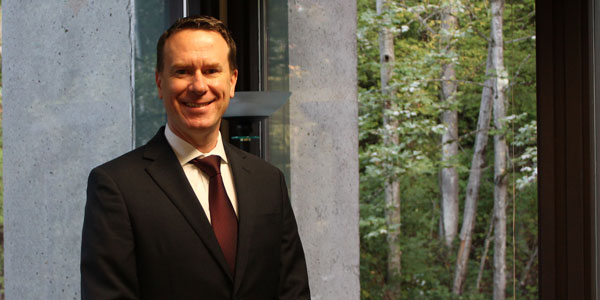
The fleets of the future
Electrification, autonomy—it makes you wonder what this industry we’ve gotten to know will look like 20 or 30 years from now. Will it even be recognizable?
Back in his sunlit office, Kevin acknowledges that there’s an inherent “fear of the unknown” when looking at the future of the industry.
“The comforting thing,” he says, “is that the industry tends to naturally evolve. For instance, as the technology matures and we implement more driver assistance systems, you can start to think of those as the building blocks to autonomy.
“When we look 30 years down the road,” he goes on, “I think we all recognize the technology will be there. It’s going to be about whether it makes business sense. That was the challenge with hybrid technology 10 years ago. It worked; it just didn’t make business sense. They weighed too much; the cost was too prohibitive.
“It has to make sense for the customers. They definitely want to do what’s right for the environment, but they still have to make money, and it’s got to work for the drivers. Drivers have to be comfortable with it. And as the technology matures, we’ll continue to evaluate it and develop it, and when the time is right, we’ll be ready.”
Service and support
Next door to Kevin’s corner office sits Laura Bloch, who in August assumed Kevin’s previous role as assistant general manager of sales and marketing. Laura came to Kenworth in February after many years elsewhere in PACCAR, most recently PACCAR Parts.
As she gets acclimated to Kenworth—meeting with customers, doing “a lot of listening”—she sees ways to bring some of the mentalities of PACCAR Parts over to the Kenworth side of things.
“At Parts, we talked all the time about customer uptime, and how we support the customer and get them their part faster,” she says. “Kenworth has focused on maximizing uptime through truck quality and service excellence. Now, we’re combining these two approaches. We want to make sure we’re supporting the customer and their needs through the whole lifecycle of the truck, from spec’ing it properly to getting it built, to getting it delivered, to the maintenance requirements and how we make sure that they’re minimized—all the way through until they buy their next vehicle. That holistic view of the customer really belongs here. That, for me, is the real opportunity.”
It makes sense. Fleets aren’t just looking for someone to sell them a truck and move on—they’re looking for a partner that will work with them on maintenance and service and on filling their needs.
“A strong dealer network is so critical to the success of a customer, especially if they’re running across state lines and dealer areas,” Laura says. “They need to know that the whole network is strong.”
Laura highlights several Kenworth service initiatives, including the PACCAR Parts 365 call center for roadside calls and the Kenworth PremierCare Gold program, which is a certification earned by dealers who meet the OEM’s list of criteria. The certification is currently held by 175 Kenworth service locations.
“If you go to a PremierCare Gold dealership, you know you’re going to a location that has expanded hours of service, and you know that you’re going to get this standard of care, which is a real selling point when you’re driving across the country and you’re not with your home dealer. You know that this dealer has met all these criteria and is going to be able to meet your needs,” Laura says.
The customer focus
What brings everything together for Kenworth is an overarching customer focus in what they do.
Kevin points to Kenworth’s customer councils as an example of this. Stephan Olsen jumps in with more details on these councils, which Kenworth has been holding for the past 14 years.
“This is a group with whom we have non-disclosure agreements, so we bring them in, we open the doors to our product development plans and our future technologies that we’re exploring. We share with them what we think the opportunities are and gather their very candid feedback,” Stephan explains. “And that’s critical to understanding and defining what the products need to be that our engineering team will then go and design.
“With the emergence of new technologies such as ADAS, we are putting an emphasis on these councils to take a deep dive into these emerging technologies, because things are moving quickly. We want to make sure that as we’re preparing for eventual rollout of those technologies, we’re representing the customer interests and needs.”
We’ve already seen the fruits of these customer councils make their way into Kenworth’s existing trucks.
“The T680 benefited deeply from close engagement with the customer councils,” he shares. “We used their input not only on the styling of the truck but the interior, because we knew that, for our truck to be successful, it had to cater to the driver. So we took that approach from the T680 development and used it on subsequent products.”
It all comes back to the importance of trust in the trucking business—something that Kevin says has been a highlight of his time in the industry.
“What I love about commercial vehicles,” he says, “is that it’s a relational business. We build trucks and solutions for customers to make money and manage their business. It’s not just about the truck or about service, it’s about the relationship that you and I have when we do business together. This entire industry is built on trust. I appreciate that more now than I ever have.
“I still love it. I hope it shows. I wake up every day and wouldn’t want to be anywhere else.”
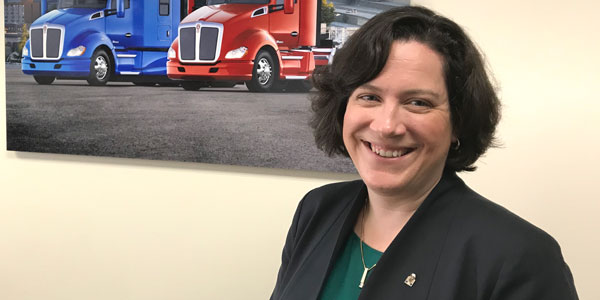
Women in Trucking
Laura Bloch highlights Kenworth’s involvement in the Women in Trucking program, and talks about the opportunities involved in bringing more women into the industry.
“How do we make sure that our industry is tapping into all of the talent that is out there? There is a lot of opportunity to draw that talent into our industry to keep us moving forward,” she says. “We have to answer: what are the impediments to doing it? What kinds of barriers keep that from becoming a desirable career? Those are the kinds of topics that we have to explore.
“I’ve loved being a part of this industry for the past 15 years, and I wish we could find more ways to showcase that it’s a great place to be.”

